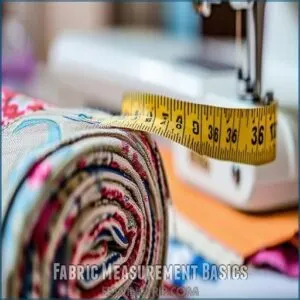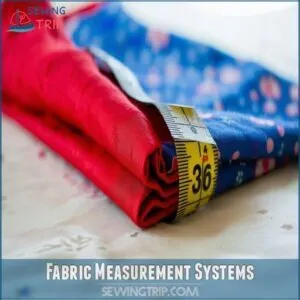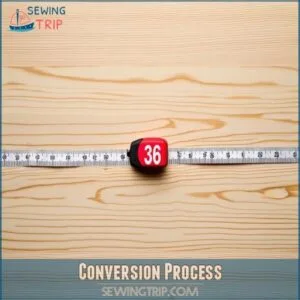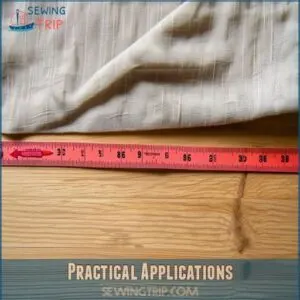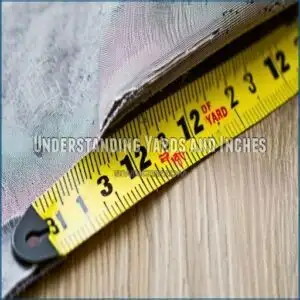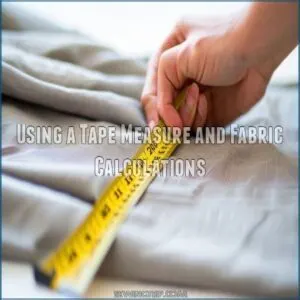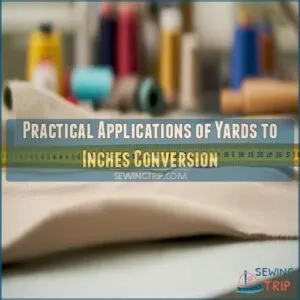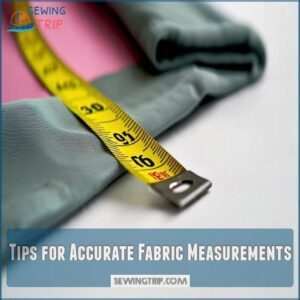This site is supported by our readers. We may earn a commission, at no cost to you, if you purchase through links.
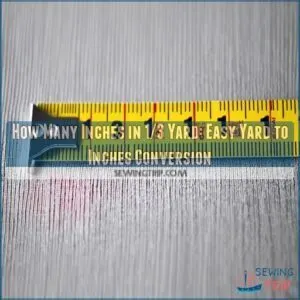
Don’t worry, converting measurements is easier than it seems.
To find out how many inches in 1/3 yard, just remember that a full yard measures 36 inches.
Break that down into thirds, and each third of a yard is 12 inches.
It’s as simple as slicing a pizza into three equal parts.
Suddenly, all your sewing and project plans are within reach with this handy conversion.
Keep this tip in mind for your next crafting adventure, and see where your new measurement mastery takes you!
Table Of Contents
- Key Takeaways
- Fabric Measurement Basics
- How Many Inches in 1/3 Yard
- Fabric Measurement Systems
- Converting Yards to Inches
- Understanding Yards and Inches
- Using a Tape Measure and Fabric Calculations
- Practical Applications of Yards to Inches Conversion
- Tips for Accurate Fabric Measurements
- Frequently Asked Questions (FAQs)
- Conclusion
Key Takeaways
- Remember that a yard equals 36 inches, so when you need to convert 1/3 yard, it’s as simple as dividing by three to get 12 inches.
- Knowing these conversions helps you measure fabric accurately, avoiding surprises in your sewing and crafting projects.
- Use a tape measure and practice converting between inches and yards to become confident in fabric measurements.
- Embrace the use of conversion apps to quickly and accurately switch between different units, saving time and reducing errors.
Fabric Measurement Basics
When measuring fabric, you’ll deal with units like yards and inches. Understanding these basics can save you from buying way too much or too little fabric for your project.
Understanding Units of Measurement
When you’re diving into fabric measurements, you’ve got to navigate two main systems: imperial and metric. They can feel like a foreign language, but don’t worry, you’ll catch on quickly.
- Metric system uses meters and centimeters.
- Imperial system features yards and inches.
- Unit conversion is key for swapping between these systems effortlessly.
Common Fabric Dimensions
Fabric comes in various widths, often ranging from 44 to 60 inches, known as bolt size.
Imagine a wide sheet of plush cotton or a sleek roll of polyester.
Standard widths, like 44 inches, work perfectly for shirts, while wider options, 54 inches, suit heavyweight projects.
Understanding these standard fabric widths helps you choose the right type for your crafting needs.
How Many Inches in 1/3 Yard
Ever stared at a sewing pattern, confused by those pesky fractions of a yard? Let’s tackle that 1/3 yard puzzle. A yard has 36 inches, right? So, a third of a yard is… you guessed it, 12 inches! That’s a handy length for many smaller sewing projects.
Need to know more? Here’s a quick guide:
- Remember that 36 inches equals one yard.
- Divide 36 by 3 to get the inches in one-third of a yard.
- That’s 12 inches!
Now you’re ready to conquer those fabric calculations. Knowing this simple conversion is key for all sorts of DIY projects, from sewing projects and home decor to even some crafty home improvements. You’ll be measuring like a pro in no time, ready to tackle any project with confidence! Mastering these small details makes a big difference.
Fabric Measurement Systems
When measuring fabric, you’ve got two main systems: the imperial and the metric.
You might stick to one or mix them up,
but knowing both can save you from a fabric fiasco!
Imperial System of Measurement
The Imperial system, like a trusty old friend, helps you measure fabric when buying or sewing, particularly in the US and UK.
With yards, feet, and inches, this system keeps things straightforward.
Perfect for everyday uses, it has its quirks and advantages.
Knowing when fractions come into play is important, but you’ll master it quickly!
Metric System of Measurement
In the Metric system, things can get a bit more straightforward. You’ll deal with units like meters and centimeters rather than yards and inches.
Here are three key perks:
- SI units make conversions a breeze.
- Using meters to measure larger distances simplifies things.
- With centimeters, you get precision for fine details.
Curious minds find this system quite handy!
Converting Between Systems
Tackling the Imperial vs. Metric system might feel like juggling two measuring tapes at once.
People have preferences for either system, but understanding both is key for mastery.
Use unit conversion tools for seamless shifts.
Focus on measurement accuracy with converting formulas for precision.
Embrace the challenge, and soon you’ll handle conversions like a pro.
Converting Yards to Inches
You’ll find converting yards to inches is a simple process: just multiply the number of yards by 36.
Whether sewing a quilt or measuring for a project, knowing this conversion is handy.
Conversion Process
Converting a yard to inches? Piece of cake. Just multiply the number of yards by 36, and you’ve got your answer in inches.
For more details on understanding fabric measurements and the different fabric widths, check out the guidelines on measuring fabric length and width.
- Always remember: 1 yard equals 36 inches.
- Use a calculator for quick math.
- Try conversion apps if you prefer digital.
- Practice with different fractions.
- Jot down conversions for frequent use.
Practical Applications
Knowing how to convert yards to inches is a game-changer.
It’s a skill that empowers you.
Imagine tackling home decor projects, confidently measuring fabric for garment making, or even building that DIY bookshelf using the right shelf board length.
Quilting becomes easier, construction projects more precise.
You’ll be a yardage whiz!
This simple conversion helps you accurately measure materials for any project, from small crafts to large-scale construction.
Understanding Yards and Inches
Understanding yards and inches helps you grasp that a yard of fabric is 36 inches or 3 feet, and knowing how much is a half yard of fabric is key to navigating the fabric world with ease. Don’t worry; once you know that a yard is 36 inches, calculating parts of a yard is a breeze.
Definition of a Yard
The yard is a standard unit of length rooted in history.
Ever wonder why it’s 36 inches long?
Originating from the average length of a human stride, the yard has seen various cultural uses.
In sewing and fabric measurement, understanding yards is essential, as a yard of fabric typically measures 36 inches in length.
- Origins of Yard: Tied to medieval measures.
- Standard Yard: Always 36 inches.
- Yard vs. Meter: Slightly shorter than a meter.
- Yard in Different Cultures: Varied definitions historically.
Definition of an Inch
While a yard gives you the whole stretch of land down the football field, an inch is a more humble measure, about the width of a grown man’s thumb.
Ever wonder why your carpenter insists on using inches? They’re precise for those close calls in carpentry.
Inches break into neat fractions, making them a handy tool compared to centimeters.
Relationship Between Yards and Inches
Understanding the relationship between yards and inches is like knowing how many cookies are in a dozen. One yard equals 36 inches, which means when you’re converting measurements, just remember: each yard has 36 little inch segments.
- 1 yard = 36 inches
- 1 foot = 12 inches
- 3 feet = 1 yard
- Think in steps
- Handy for sewing
Using a Tape Measure and Fabric Calculations
Grab your tape measure and get ready to master fabric calculations. By converting inches to yards, you’ll handle any sewing project with ease.
Measuring Fabric in Inches
When you’re diving into sewing projects or quilting yards, measuring fabric in inches is really important.
Grab a tape measure; it’s your best buddy.
Knowing that a half yard of fabric is equivalent to 18 inches is essential, so be sure to check half yard fabric measurements to avoid any confusion.
Whether you’re cutting upholstery fabric or planning an intricate design, knowing fabric width and length helps avoid mishaps.
Picture it: getting halfway through a project only to realize you’re short on fabric length.
Converting Inches to Yards
So, you’ve measured your fabric in inches? Great! Now, let’s change those inches to yards.
It’s a cinch! Remember, there are 36 inches in every yard.
To convert, simply divide your inch measurement by 36.
For example, 72 inches equals 2 yards. See? Easy peasy!
This is a key skill for any sewing project. Accurate fabric calculations are essential for success.
You’re mastering fabric measurements!
Using Unit Converter Apps
Embrace unit converter apps for seamless fabric calculations. Here’s why:
- App Accuracy: Trust precise yard-to-inch conversions without manual errors.
- Converter Features: Handy tools let you switch between measurements quickly.
- User Interface: Intuitive designs make navigation a breeze.
Whether on mobile or desktop, these apps are your ticket to mastery, saving time and effort.
Practical Applications of Yards to Inches Conversion
Understanding how to convert yards to inches can make your sewing and home projects a breeze.
Knowing the conversion helps keep things exact.
Whether you’re sewing a new curtain or marking a football field.
Sewing and Fabric Projects
Stitching up a storm? Converting 1/3 yard to inches—12 inches exactly—can simplify your fabric yardage planning.
For even more precise measurements, use online resources like sewing fabric inches to find the right tools and supplies for your project.
Whether it’s savvy project planning or picking the right sewing patterns, knowing these conversions keeps you in control.
Different fabric types require precise measurements; your sewing tools should become second nature, helping each stitch align perfectly in your crafting journey.
Home Improvement Projects
In DIY projects, understanding how 1/3 yard equals 12 inches gives you control over project planning.
Whether it’s choosing the right tools or budgeting for materials, these conversions make a difference.
For those planning to purchase lumber for their projects, checking out 1/3 yard lumber options can be helpful.
Remember, it’s not just fabric; it applies to all material sourcing.
Think of measurement conversions as your trusty sidekick, always ready to save the day in home improvement.
Sports and Athletics
Sports and athletics demand precise measurements. Whether measuring track events or sizing athletic uniforms, knowing yard-to-inch conversions helps. Here’s why:
- Track Events: Lanes and distances use yards and inches for accuracy.
- Field Events: Equipment sizing and placement rely on specific measurements.
- Sports Fields: Dimensions and markings are essential.
- Uniforms: Proper fits enhance performance and comfort.
Accurate conversions make a difference!
Tips for Accurate Fabric Measurements
Accurate fabric measurement is essential whether you’re sewing curtains or crafting a dress.
Accurate fabric measurement is essential whether you’re sewing curtains or crafting a dress.
Understanding conversions and using reliable tools will streamline your projects and prevent those "Oops, I bought too much!" moments.
Practicing Measurement Conversions
Mastering fabric measurements? Practice makes perfect! Grab a tape measure and some scrap fabric.
Convert inches to yards, then yards to meters.
When working with different fabric widths, remember that wider fabrics can be more cost-effective and reduce wastage, as seen in the guide to yardage conversion charts.
Try converting metric to imperial and back again.
Soon, you’ll be a pro at yard to foot conversions and inch to centimeter calculations. It’s like learning a secret code—once you get it, it’s easy!
Don’t be afraid to make mistakes; that’s how you learn.
Remember, even experienced sewers use conversion charts sometimes.
Streamlining Fabric Shopping and Sewing
Fabric shopping can be easy if you know a few tricks. First, keep a list of your common fabric yardage requirements handy. It speeds up sewing project planning.
Second, check online fabric stores for deals before heading out.
Finally, organize your space with fabric storage solutions to simplify fabric cutting.
- Create a fabric yardage cheat sheet
- Explore online fabric stores
- Invest in practical fabric storage
Frequently Asked Questions (FAQs)
What is the history of the yard?
The yard has roots in medieval England, likely originating from the length of a man’s belt or stride.
It evolved for trade and daily use, now standing at 36 inches, integral to the Imperial measurement system.
How is fabric sold by the bolt?
Ever wondered how fabric is sold by the bolt?
You typically buy it in pre-measured amounts varying by width and length, often ranging from 30 to 100 yards.
Check the label for specifics before purchasing.
What are common fabric widths?
You’ll find common fabric widths range from 44 to 60 inches. That’s a pretty wide range, isn’t it? Knowing this helps you plan your projects better. It also avoids costly mistakes!
How do you calculate fabric needs?
Think of planning a road trip: you calculate miles by route, right?
For fabric, estimate based on project type, fabric width, and pattern repeats.
Add a bit more for mistakes or adjustments.
Simple, like packing snacks!
How do metric and imperial systems differ in sewing?
In sewing, metric and imperial systems differ by their units: metric uses meters and centimeters, while imperial relies on yards and inches.
Metric is precise and global, but imperial, common in the U.S., feels traditional.
Conclusion
Remembering how many inches in 1/3 yard can boost your crafting confidence.
Knowing a yard is 36 inches, it’s easy to see that 1/3 yard equals 12 inches.
Use this handy tip for sewing, home projects, or just impressing friends.
With a bit of practice, you’ll master fabric measurements and simplify your projects.
Keep this conversion in mind, and let your new skills take your creativity to exciting new heights, whether you’re sewing, building, or organizing.

